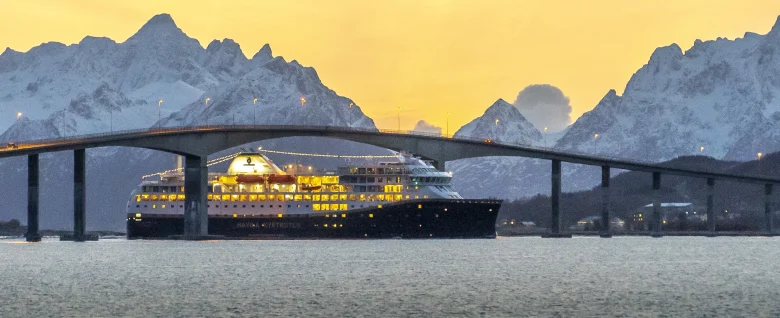
Havila Voyage Handy Hints
Our 'helpful hints' guide to your Norwegian Coastal Voyage with Havila. Many of our Scandinavian staff have travelled on a coastal voyage and offer detailed explanations to how it works on-board.
Our staff will respond to your query promptly and provide detailed information to your questions.
6 days - Norwegian Coastal voyage travelling South.
From the tip of Norway, voyage south along the spectacular Norwegian coast. Travel along the beautiful coast of Norway from Kirkenes to Bergen, and get to experience the world's most scenic sea voyage. The 6 day voyage south calls at over 30 ports, clinging close to the coast as you weave through the legendary Lofoten Islands famous for stunning nature and idyllic fishing sites.
This trip suits a stay beforehand in the Kirkenes Showhotel. Likewise, arriving in Bergen at the end, you have numerous possibilities to extend your holiday to see more of this spectacular country.

As a Certified B Corporation, 50 Degrees North has designed this tour using handpicked local hoteliers and suppliers who share our ethos of delivering services and activities of high social and environmental standards.
The CO2-e per person per day of all tours is carefully measured following each season. We fully offset all emissions of our tours on your behalf, and we constantly look at ways to reduce emissions where possible.
Hurtigruten Coastal Ferry
Click here to see the Hurtigruten fleet - Norwegian Coastal Voyages.
Click here to see the Havila fleet - Norwegian Coastal Voyages.
View the Havila Deckplan here.
All prices are for your voyage only, based on two people travelling together and sharing a twin cabin. Your voyage price includes: Voyage in a cabin grade of your choice including all meals, 24-hour emergency service and taxes and service fees.
Rates fluctuate daily and we can often find discounts up to 25% depending on departure date and proximity to travel. Please ask us for a specific quote for your preferred dates. PLEASE NOTE: This is a FROM price and will not apply during the high season (May to September).
Flights, travel insurance, luggage handling & optional excursions.
Ports visited today: Båtsfjord, Vardø, Vadsø, Kirkenes, Berlevåg.
Join your voyage in Kirkenes as the ship turns around to travel southbound. As the ship starts its voyage south, you can first enjoy lunch followed by views of the surrounding Arctic landscape on deck or from the panorama lounge.
In the afternoon, the ship again docks at Vardø, Norway’s easternmost port. Weather permitting, we may invite you to experience ice bathing in the Arctic Ocean. On board in spring, there is a presentation about shorebirds residing along the Nordic coastline. Heading south, we cruise along the Varanger peninsula to Båtsfjord, before reaching Berlevåg in the evening. The latter town is home to one of Norway’s most famous male choirs, consisting mainly of local fishermen.
If you are wishing to add some activities before your voyage, please talk to us directly about what is available depending on the season of travel.
Ports visited today: Mehamn, Kjøllefjord, Honningsvåg, Havøysund, Hammerfest, Øksfjord, Skjervøy, Tromsø.
In the middle of the night, dock at Mehamn, where it is possible to join an unforgettable snowmobile trip through one of Europe's most extreme and exciting natural areas during winter time. Experience snow-clad valleys, fresh winter air and perhaps the mesmerising Northern Lights in the clear, starry sky.
At Honningsvåg you can join an excursion that features breakfast at North Cape and the discovery of hidden parts of Finnmark along the way between May and October. Before stopping in Hammerfest, you can enjoy an 'energy coffee' and short introduction to Melkøya - the world´s northernmost natural gas terminal'. Hammerfest was founded in 1789, and over time became Norway's polar capital, serving as a base for hunting expeditions into the High Arctic. Here you can see the UNESCO-listed Meridian Column, erected in 1854 to commemorate the first precise geographic measurement of the globe. In winter, you can also join a mini-mountain expedition to experience the Arctic outdoors and learn about local polar hero and cook, Adolf Henrik Lindstrøm.
We continue south to Øksfjord. After crossing open water, we make a brief stop at the old trading post of Skjervøy. In spring, we sail through the beautiful Lyngenfjord, surrounded by the snowy peaks of the Lyngen Alps: Here, you might get a taste of fresh locally-caught prawns.
We then dock at Tromsø, just in time to enjoy a magical midnight concert at the Arctic Cathedral. In summer, you can join a midnight excursion, under the Midnight Sun, to explore Tromsø by sea in a RIB boat. Alternatively, a walk around the town provides you the chance to enjoy a local brew at one of the city´s many friendly pubs.
Optional Excursions depending on the season: Snowmobile trip in the Polar Night, Breakfast at the North Cape, the Northernmost Town in the world Hammerfest, Into the Ice - Stories of a Polar Hero, Mountain Hike in Hammerfest and Midnight concert in the Arctic Cathedral.
Today you will pass through Risøyrenna, a channel providing vessels an 'inside route' between Harstad and Sortland. Coming into Sortland- the blue city, local artist Bjørn Elvenes came up with the idea of turning the city into a three-dimensional artwork using a blue colour palette. You then continue onto Stokmarknes, where you will see the MS Finnmarken as a monument as you come into port. You can also learn about Norway's coastal history at the Hurtigruten museum.
Continuing south from Stokmarknes it looks as if you are sailing straight through the mountain wall, but you wail through an opening in the narrow Raftsundet, a picturesque narrow channel between the Vesterålen and Lofoten islands. If time and weather permits, you will take a detour into the spectactular Trollfjord where steep cliffs hug the ship's sides, home to the majestic sea eagles. The daylight sailing through the Lofoten Islands is a highlight for many as the Lofoten region is renowned for its natural beauty with steep mountains, fishing villages and beautiful scenery.
Svolvær is the main settlement on the Lofoten Island followed by Stamsund where the majestic peaks of the huge Lofoten Wall can be viewed.
Ports visited today: Bodø, Ørnes, Nesna, Sandnessjøen, Brønnøysund, Rørvik.
Crossing the Arctic Circle at 66°33’N is an important ‘rite of passage’. Today we celebrate the event out on deck with a `taste´ of Arctic tradition – a spoonful of cod liver oil. As we sail along the Helgeland coast, you pass hundreds of islets, fertile farmland and steep granite walls rich in local lore. On deck you can see the strange mountain Torghatten (rising 258 m above sea level), famous for its distinctive hole right through the middle. The hole is 160 m long, 35 m high and 20 m wide, and was created during the ice age.
Another highlight is sailing past the Seven Sisters mountain range. All seven mountains are between 900 and 1,100 m high, and it is easy to understand how these ‘ladies’ influenced ancient myths. The story goes that there were seven troll sisters, the daughters of King Sulis, who kept them under strict control. One night, when the king fell into a deep sleep, the seven maidens sneaked out. Vågekallen, who was eager for a wife, was lying in wait. He pursued the sisters, who fled southwards down the coast. Several other trolls joined the chase to either capture or rescue them. When night turned to morning, the troll sisters and their pursuers were petrified as the sun turns all trolls to stone. They all became the rocks and mountains that today make the Helgeland coastline one of the most beautiful places on earth.
Next we make a short stop at Nesna, an idyllic old trading post before moving on to Sandnessjøen. The UNESCO World Heritage Site of the Vega Islands is close to Sandnessjøen and can be visited on an optional excursion during summer. This unique cultural landscape consists of dozens of islands. The UNESCO designation was awarded due to the unique interaction between the eider duck and island population. Learn how the fishermen and farmers have cultivated a centuries-old symbiotic relationship with the ducks, and how it continues to contribute to a livelihood of eiderdown harvesting and making down-filled duvets.
As we arrive in Brønnøysund, you can join the excursion to visit to the Norwegian Aquaculture Centre near Brønnøysund for an informative tour and taste of fresh salmon from April throughout October.
Optional Activities depending on the season: UNESCO Islands Vega and Visit a Salmon Farm.
Ports visited today: Trondheim, Kristiansund, Molde, Ålesund.
Today provides another opportunity to explore the city of Trondheim. Back on board, the ship heads out into the majestic Trondheimsfjord, which is 170 km long and up to 25 km wide. Like all other Norwegian fjords, it is deep, plunging to 577 m.
As we sail along the coast, you realise the importance of fish to Norwegian coastal communities. Kristiansund’s location has steadily provided the town with a wealth of opportunities in the fishing, shipbuilding and oil industries. Kristiansund is today regarded as Norway’s ‘dried cod capital’ because of its long-time export of salted dry fish. Here you can join an excursion to the renowned Atlantic Road, one of Norway’s most visited tourist destinations. It is 8.2 km long, built on a total of eight bridges and surrounded by picturesque landscapes and open sea.
Another interesting excursion is to the Bergtatt marble mine, which includes entering a mountain and sailing across an illuminated subterranean lake, before enjoying a meal in the mines ‘Grand Hall’. Those choosing to stay on board at Kristiansund will experience the ships crossing the open sea on our way to Molde, known as Norway´s ‘City of Roses’. Along the way you see see the steep, grey, pointed peaks of the Romsdal Alps.
Optional Excursions depending on the season: The Atlantic Road, Marble Mine tour, The hidden rooms of Nidaros Cathedral and Trondheim with Nidaros Cathedral.
Ports visited today: Ålesund, Torvik, Måløy, Florø, Bergen.
During the night, the ship calles at Ålesund, Torvik & Måløy, as the world's most beautiful voyage draws to an end.
Today, your voyage will come to an end when you arrive in the City of Seven Mountains, Bergen. But before that, you still have a few nautical miles of fascinating scenery ahead of you such as the picturesque Nordfjord below the enormous Jostedalsbreen glacier, Norway’s longest fjord - the mighty Sognefjord and the picturesque Bergen Archipelago. Take home your memories of the world’s most beautiful voyage and the many seafaring companions and friends you’ve made along the way.
Enjoy an optional city walk in Bergen.
Please note the below prices are indicative only, and are the from prices, per person. Prices may fluctuate daily, so please contact us for any specials, early booking rates and/or specific prices for your preferred date of travel.
Our Scandinavian staff offer expert advice on ships, cabins and routing, as well as the best time to travel.
When securing your cabin with us, please take note of the dimensions of the cabin to ensure that you are satisfied with it's size. There is additional storage room available on board if you wish and you just need to contact staff to request it when you are on board.
You can pre-book your optional excursions with us. However, you can also wait until you are onboard and do it then - however, there is a maximum number and they can book out. It is not possible to pre-book within 2 weeks prior to departure. Excursions and their contents are subject to maximum/minimum numbers and weather/local conditions.
IMPORTANT NOTE: Weather conditions may occasionally affect certain activities, and as a result, the schedule may be adjusted to ensure the best possible experience for all guests. For multi-activity stays, often the order of the activities will be confirmed locally on arrival. Activities might vary slightly in their duration or location due to the weather and local conditions. Any activities that are unable to be re-scheduled due to weather conditions, will be refunded as a general practice, as determined by the activity provider.
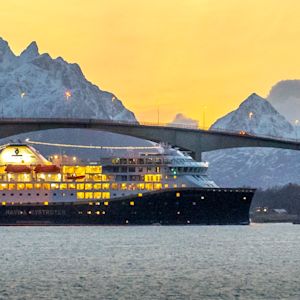
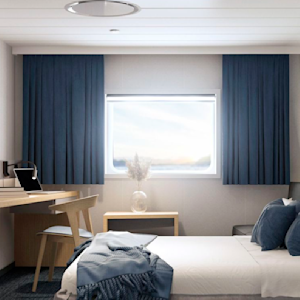
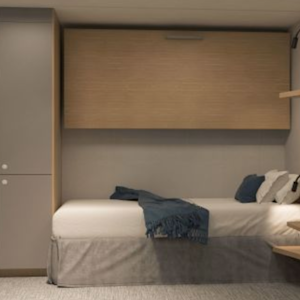
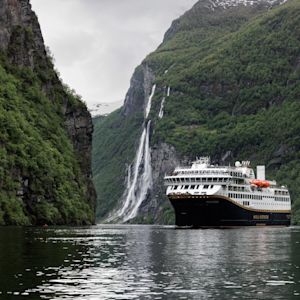

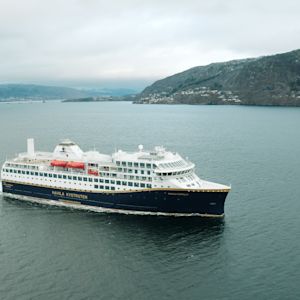
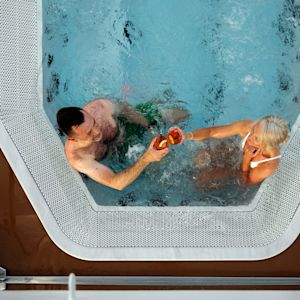

Our 'helpful hints' guide to your Norwegian Coastal Voyage with Havila. Many of our Scandinavian staff have travelled on a coastal voyage and offer detailed explanations to how it works on-board.

Our 'helpful hints' guide to your Norwegian Coastal Voyage with Hurtigruten. Many of our Scandinavian staff have travelled on a coastal voyage and offer detailed explanations to how it works on-board.
Learn what to pack for your Lapland winter adventure. Stay warm, travel smart, and enjoy the Arctic snow.
Norwegian coastal ships are working vessels operating a regular service to a set timetable, and a set itinerary, carrying goods, vehicles and foot passengers between ports, by night and day, as an integral part of Norwegian daily life (some noise may be experienced during docking and loading/unloading). It may very occasionally be necessary to omit or curtail stops due to weather or other conditions. Some stops may be very short and some are at night. As Christmas approaches itineraries may change in order for ships to host dinners and celebrations for local communities. Please ensure you are back onboard by sailing time, especially if the ship has arrived late, as it may leave as scheduled to make up time.
The departure time is advertised at the gangway and vessels are NOT able to wait for passengers who are late. If you miss the ship it is your responsibility to make arrangements to rejoin the voyage at the next possible stop or return home.
This is generally available 24 hours a day serving beverages, sandwiches and a small selection of hot and cold dishes. On some departures the catering service at night will be managed by the reception staff.
If you are travelling by car further information on vehicles and parking at ports is available from Hurtigruten. Access to the vehicle deck is only permitted when the ship is moored.
Ships generally accept VISA, American Express, Eurocard, Diners Club and JBC International, plus most currencies.
We recommend that passengers acquire a cruise card to make payments on board. This may be obtained from reception onboard and used to make payments throughout the ship. They accept credit cards or cash as a deposit. You need to get the bill sorted on the last night to be sure it is finalised.
Special diets, such as vegetarian must be ordered well before departure.
All ships have lifts and cabins for disabled guests. People with severe disabilities or who are unable to take care of themselves must be accompanied by a carer.
The ships are licensed to sell drinks onboard, however please note the price of alcohol in Norway due to heavy taxes. The water package can be included into your voyage at a small extra cost
220 V AC 2 pin, and a continental adaptor is required.
Available on all ships.
Be sure to bring some swimming attire for the jacuzzi!
All ships offer internet access via satellite. In most harbours, mobile/cellular networks (3G) are available if bringing your own PC and a mobile access subscription. The wireless coverage varies from ship to ship and will be improved yearly. The passengers have to contact the reception on board for information on how to get access to the internet (free of charge). No internet access in the cabins (except in some suites). Internet cafe (if present), with minimum 2 PCs.
Kystruten ships are working vessels operating a regular service to a set schedule, carrying vehicles, cargo and foot passengers by day and night (some noise may be noticed during docking or loading). Some stops are short and/or are during the night. It may occasionally be necessary to omit or curtail visits due to weather/local conditions, and you will be notified of this.
Most ships have laundry facilities with washing machines and tumble dryers. Tokens may be purchased from reception.
A daily baggage service is available in Bergen from the airport and selected city-centre hotels to the Hurtigruten terminal. For groups, luggage handling must be agreed with Hurtigruten prior to travel. This in not included in the price of your voyage.
Meals are served at set times in the restaurant. In high season, times may vary if there are several sittings. A breakfast buffet (open seating) with a wide selection is served 07.30hrs -10.00hrs. A buffet lunch (open seating) with hot and cold dishes and desserts is usually served 12hrs-14.30hrs and a three course set dinner 18.30hrs-21.00hrs. In Bergen a buffet is usually served 18.30hrs-21.30hrs. Exact times are given on board. Tea and coffee facilities are only provided in cabins above U Class. Tea and coffee are available free of charge after lunch and dinner but can be purchased around the clock. Please read our news articles about dining on board Hurtigruten.
It is recommended that pets are not brought on long journeys and special rules apply to the transport of animals; contact us for further information. We do however welcome guide dogs on board.
As there are only short distances between ports there is neither a doctor nor a pharmacy on board.
Most ships have a playroom except MS Midnatsol and MS Trollfjord.
Do not forget to bring your binoculars, camera and/or a video camera. Take practical, warm and windproof clothing for going out on deck. Smart, but casual clothes are recommended on board. Good comfortable footwear is vital for excursions.
Souvenirs, knitwear, postcards, DVDs of the journey, stamps and a small supply of toiletries are sold on board.
Smoking is not permitted in cabins or public areas. It is allowed up on the open deck but prohibited at all times when the ships are in port.
For reasons of safety it may sometimes be necessary to keep cabin ventilators/port-holes obscured.
All ships have payphones and a fax machine. There is generally good coverage for mobile phones.
There is a tour leader on board all year round. On some departures this service is managed by reception. External tour leaders (groups) are requested to contact the reception for information on practical details.
We can offer transfers in Bergen, Trondheim and Kirkenes.
There is a safe in reception. Ships accept no responsibility for valuables and money kept in cabins.
When arriving at night disembarking passengers are woken between half an hour and one hour before arrival.
Temperatures usually vary between 2°C and -10°C in winter. Summer temperatures in northern Norway vary between 10°C and 30°C depending on latitude.
On your final morning of your voyage, be sure to take everything with you when you go for breakfast. The ship gets prepared for the next voyage and your rooms will be cleaned promptly. You may be charged for re-entry.
You can pre-book your optional excursions with us. However, you can also wait until you are onboard and do it then - however, there is a maximum number and they can book out. It is not possible to pre-book within 2 weeks prior to departure. Excursions and their contents are subject to maximum/minimum numbers and weather/local conditions. During quieter months, some excursions may not get the numbers required so please ask us when booking about the minimum numbers needed for each excursion.
Travel insurance is compulsory for all tours with 50 Degrees North. The safety of our travellers, staff and operators is a major priority of 50 Degrees North. With an operational office in Norway, 50 Degrees North has access to an up-to-the-minute flow of information regarding the countries we work in. We are also in regular contact with the various operators we use. Their in-depth knowledge and understanding of their various areas is vital.
Norway has a few items that typically surprise travellers when visiting Norway for the first time. Alcohol and luxury items are heavily taxed and therefore prices are higher than you might expect. On the other hand, necessities such as bread and milk, are taxed low and therefore are great value.
We recommend that you bring all the alcohol you’re allowed to bring into the country when you arrive. There are many lovely parks and balconies where you can enjoy your duty free. However, be sure not to bring more than you’re allowed!
As of May 2014, the allowances according to Visit Norway are:
Alcoholic beverages:
Minimum age: 18/ 20*
1 litre of beverages with more than 22% up to and including 60% alcohol per volume as well as 1½ litre with more than 2.5% up to and including 22% alcohol per volume or three litres with more than 2.5% up to and including 22% alcohol per volume
and
2 litres of beer with more than 2.5 % or other beverages with more than 2.5% up to and including 4.7% alcohol per volume.
This means that you may for example bring with you five litres of beer provided you do not have any other alcoholic beverages with you.
*For importing alcoholic beverages with more than 22% alcohol per volume the minimum age is 20.
It’s illegal to bring extra alcohol into Norway and can end up costing you. Another thing you should bring and not buy in Norway is razor blades. Good razor blades in Norway are expensive.
In winter, Norway becomes a picturesque world of snow and ice. As beautiful as this is, it's also incredibly cold. Here's how to dress for travel near the arctic during the coldest parts of the year:
Underwear
One of the most effective ways to stay warm in cold weather is to invest in a good set of thermal underwear. This bottom layer helps trap the heat your body produces, and effectively uses your own warmth as a radiator.
When it comes to choosing long underwear, you have to give the material serious thought. Most thermal underwear is made of either wool or high-tech yarn. To be truly warm, you'll want to go for something that's designed with channels that trap your heat while also wicking away any moisture you produce. Damp clothes in the arctic is a recipe for disaster, so focus on materials that will keep you warm and dry.
Your long underwear should cover your entire torso, and your arms and legs down to your wrists and ankles. You might also find versions of this layer that include a turtle neck, which gives you an extra protected area.
Indoor layers
These are the layers you'll have exposed when you're out of the elements - basically, this layer is your chance to show off your sense of style. Norwegian fashion is the epitome of form meets function, which means that sweaters and other knitwear make up the popular look during the cold season.
Go for choices that reflect your personality while still keeping you nice and warm. If you're a fan of skirts, make sure you've invested in a good pair of knit leggings that will keep you warm. However, it's a better bet to go for pants if you're really focused on comfort. Fleece-lined jeans are a great choice for the coldest time of year.
It might not be a bad idea to have a fashionable short-sleeved shirt between your bottom layer and this one, just in case you go into a particularly warm location. It's easy to end up overheated when you're wearing multiple insulating layers, so you'll thank yourself if you have an opportunity to shed one in a well-heated store or restaurant.
Outdoor layers
Depending on how far north you're heading, you'll want to be well-stocked in outer layers. For your upper half, wear a water and windproof shell or jacket, and then a full winter coat to wear over that. At least one of these should have a hood, but it's better if they both do.
If you're going to be trekking through lots of snow, or if you're just going to be in freezing weather for an extended period of time, you may also want to bring a layer of waterproof pants. Although you may feel awkward shedding and replacing these pants when you transition from indoors to outdoors, your legs will appreciate the extra protection.
Hands and feet
Your hands and feet are two of the most important parts of your body to protect in cold weather. Along with your ears and nose, these are the parts of your body most likely to end up with frost bite. That's why you need to have good socks, shoes and gloves when you're spending time in or near the arctic.
Wool, moisture-wicking socks are your best bet for keeping your toes warm when walking through snow and sleet. You'll also want to invest in a pair of heavy-duty snow boots. Good waterproof boots will keep your feet from getting soaked, and help you keep traction on slippery surfaces.
When it comes to your hands, you have a couple of good options. Your best bet for warmth is insulated mittens, as these trap the heat from your fingers. However, mittens aren't particularly functional. A good alternative that won't limit dexterity is a good pair of knit gloves. If you can, find a pair that will work with a touch screen. This way, you won't have to partially remove your glove if you need to make a phone call.
Accessories
In addition to your coat and pants, you're going to want to pack plenty of warm accessories. Knit scarves and hats will help you protect your face and head from the chill. You'll also want to bring a warm pair of ear muffs to keep this sensitive area covered. Remember, your nose and ears are particularly at risk for developing frost bite, so you'll want to take extra care to make sure they're safe and warm.
Other Packing Tips
Consider getting a waterproof lining for your suitcase, since you'll probably be carrying it through snowy or wet conditions. If you have any electronics in your bag, these should absolutely be kept in a waterproof container for protection.
It's a good idea to bring an extra hat, scarf and piece of ear protection when you're out and about. These pieces are easy to drop - you'll appreciate having a spare on hand if your hat ends up covered in snow.
Although for most trips it's best to bring as little as possible, it's not a bad idea to err on the side of bringing too much when it comes to the arctic. You can always remove layers, but you can't add what you don't have.
_Information supplied by Hurtigruten USA. _